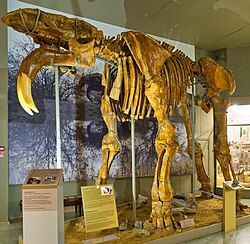デイノテリウム科
| デイノテリウム科 | ||||||||||||||||||||||||||||||||||||
|---|---|---|---|---|---|---|---|---|---|---|---|---|---|---|---|---|---|---|---|---|---|---|---|---|---|---|---|---|---|---|---|---|---|---|---|---|
 デイノテリウム アゾフ歴史考古学古生物学博物館(ロシア) | ||||||||||||||||||||||||||||||||||||
| 地質時代 | ||||||||||||||||||||||||||||||||||||
| 古第三紀漸新世 - 新第三紀鮮新世 | ||||||||||||||||||||||||||||||||||||
| 分類 | ||||||||||||||||||||||||||||||||||||
| ||||||||||||||||||||||||||||||||||||
| 学名 | ||||||||||||||||||||||||||||||||||||
| Deinotheriidae Bonaparte, 1845 | ||||||||||||||||||||||||||||||||||||
| 亜科 - 属 | ||||||||||||||||||||||||||||||||||||
|
デイノテリウム科(デイノテリウムか、学名:Deinotheriidae ) とは、ゾウ目の絶滅した科である。学名は、「恐ろしい」(Deino) と「獣」(therium) を意味する[1]。
チルガテリウム・プロデイノテリウム・デイノテリウム の3属が含まれる。
形態
[編集]デイノテリウム科の体の形とプロポーションは、現代のゾウのそれによく似ているが、以下のような特徴があった。

- 牙
- 鼻

- 歯
- ポストクラニアル (体骨格)
 |  |
属による形態の違い
[編集]大きな違いはサイズで、時代が新しくなると共にサイズが大きくなっている [7]
- 肩の高さの違い
- その他の各属の差異
- プロデイノテリウムの形態特性についてはプロデイノテリウム#形態を参照。
- チルガテリウムの形態特性についてはチルガテリウム#形態を参照。
生息時代・生息域
[編集]デイノテリウム科は、古第三紀の漸新世から新第三紀を跨いで第四紀の更新世まで生息していたと考えられている。 およそ2600万年もの長きに渡って科が存続したことになり、長鼻目の中でも成功した系統であるといえる[5][8]。
| 古第三紀 | 新第三紀 | 第四紀 | ||||||
|---|---|---|---|---|---|---|---|---|
| 暁新世 | 始新世 | 漸新世 | 中新世 | 鮮新世 | 更新世 | |||
| 66 - 56M | 56 - 34M | 34 - 23M | 23 - 5M | 5 - 2.6M | 2.6- | |||
| デイノテリウム科 生息時代 | ||||||||
デイノテリウム科は、最初はアフリカに出現し、その後南アジア (インド - パキスタン) とヨーロッパに広がった。その間、サイズがはるかに大きくなったことを除けば、形態はほとんど変化していない。中新世後期までに、彼らは当時最大の陸上動物になっていた。 さまざまなマンモスやマストドン類の系統とは異なり、デイノテリウム科は氷河時代を通じて存続するのではなく、更新世の初期に絶滅した[9]。
生態
[編集]
デイノテリウム科は森林の近くに生息し、高木になる木の芽や果実を食べる摂食行動を取っていたとして知られている。 下向きの牙は樹皮や他の植物を剥ぐのに用いられ、鼻はバクのように植物を掴んで舌で操作できる場所に移動させるために使われていた[2]。
植物食の動物は、ブラウザー(木の芽や枝葉を食べる)・グレイザー(草を食べる)・ミックスフィーダー(どっちも食べる)という3つの摂食タイプに分けられるが、化石でも臼歯の状態で摂食タイプを判断することができる。グレイザーは砂を含むことがあり歯に擦り傷が多く残るのだが、デイノテリウム科の臼歯にはそのような磨耗はほとんど見られず「ブラウザー」と診断されている[10]。 同一時代・同一地域にミックスフィーダーとされるゴンフォテリウムも生息していたことが分かっているが、摂食嗜好の異なる種は直接の食物競争を回避することができるため、同一地域で共存可能(ニッチ分化)であった[10]。
デイノテリウムの臼歯は、前三本(P3-M1) が食物を砕く目的で使用し、奥二本(M2-M3)を植物材料を剪断(スライス)するのに使用していたと考えられている。剪断に用いられる第2と第3大臼歯は垂直方向に強く働き、横方向(左右方向)にはほとんど作用しない。この咀嚼動作は、ゴンフォテリウム科(横方向のすりつぶし) やゾウ(水平方向の剪断)に見られる歯の動作とは異なる[11]。
デイノテリウム科の中でも原始的なチルガテリウム・プロデイノテリウムは、上記の摂食嗜好から森林の近くに張り付いて生活していたと考えられているが、より大型のデイノテリウムに進化すると前脚が長くなり高い走行性(効率的な歩幅)を手に入れている[1]。中新世後期のヨーロッパにおけるサバンナの広がりへと適応して、広大で(彼らにとっては)役に立たない草原を横切り、おそらく森から森へと移動していたとされる。
分類
[編集]下位分類
[編集]| デイノテリウム科 |
| ||||||||||||
| Deinotheriidae |
脚注
[編集]- ^ a b Record of Prodeinotherium (Proboscidea; Mammalia) from the Mid-Tertiary Dharmsala Group of the Kangra Valley, NW Himalaya, India
Tiwari et al, (2006) - ^ a b c A reconstruction of the facial morphology and feeding behaviour of the deinotheres
Markov et al, (2001) - ^ 生命の大進化40億年史 新生代編
土田 (2023), p. 144 - ^ Systematics and Taxonomy of the European Deinotheriidae
Huttunen (2002a) - ^ a b c New large-bodied mammals from the late Oligocene site of Chilga, Ethiopia
Sandars et al, (2004) - ^ a b Shoulder height, body mass and shape of proboscideans
Larramendi (2016) - ^ 各属のサイズの根拠は個別の説明ページを参照のこと。
- ^ Deinotherium in the Pleistocene Wayland (1932)
- ^ The record of Deinotheriidae from the Miocene of the Swiss Jura Mountains (Jura Canton, Switzerland)
Gagliardi et al, (2021) - ^ a b Feeding preferences of Gomphotherium subtapiroideum (Proboscidea, Mammalia) from the Miocene of Sandelzhausen
Calandra et al, (2010) - ^ Deinotheriidae (Proboscidea, Mammalia) dental remains from the Miocene of Lower Austria and Burgenland
Huttunen (2002b)
参考文献
[編集]- Tiwari, B.N.; Verma, B.C.; Bhandari, A. (2006). “Record of Prodeinotherium (Proboscidea; Mammalia) from the Mid-Tertiary Dharmsala Group of the Kangra Valley, NW Himalaya, India: Biochronologic and Biogeographic Implications”. Journal of the Paleontological Society of India 51 (1): 93–100.
- Markov, G.N.; Spassov, N.; Simeonovski, V. (2001). “A reconstruction of the facial morphology and feeding behaviour of the deinotheres”. The World of Elephants – International Congress: 652–655.
- 土屋 健『カラー図説 生命の大進化40億年史 新生代編』講談社 BLUE BACKS、2023年。ISBN 978-4065336472。
- Huttunen, K. (2002). “Systematics and Taxonomy of the European Deinotheriidae (Proboscidea, Mammalia)”. Annalen des Naturhistorischen Museums in Wien 103 A: 237–250.
- Huttunen, K. (2002). “Deinotheriidae (Proboscidea, Mammalia) dental remains from the Miocene of Lower Austria and Burgenland”. Annalen des Naturhistorischen Museums in Wien 103 A: 251–285.
- Larramendi, A. (2016). “Shoulder height, body mass and shape of proboscideans”. Acta Palaeontologica Polonica 61. doi:10.4202/app.00136.2014.
- Sanders, William J.; Kappelman, John; Rasmussen, D. Tab (2004) (英語). New large-bodied mammals from the late Oligocene site of Chilga, Ethiopia. Acta Palaeontologica Polonica 2024年4月20日閲覧。.
- E. J. WAYLAND (1932年). “Deinotherium in the Pleistocene” (英語). nature. 2024年4月20日閲覧。
- Gagliardi, Fanny; Maridet, Olivier; Becker, Damien (2021) (英語). The record of Deinotheriidae from the Miocene of the Swiss Jura Mountains (Jura Canton, Switzerland). bioRxiv. doi:10.1101/2020.08.10.244061.
- Calandra, I.; Göhlich, U.B.; Merceron, G. (2010). “Feeding preferences of Gomphotherium subtapiroideum (Proboscidea, Mammalia) from the Miocene of Sandelzhausen (Northern Alpine Foreland Basin, southern Germany) through life and geological time: evidence from dental microwear analysis”. Paläontologische Zeitschrift 84: 205–215. doi:10.1007/s12542-010-0054-0.


 French
French Deutsch
Deutsch
